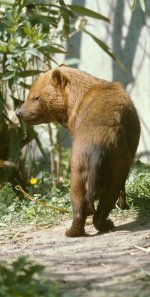 The bush dog (Speothos venaticus) can be found from Panama to Argentina. Despite its extensive range, it can seldom be seen and is very rare. It was even thought that bushdogs were extinct, because fossils of the bush dog caused the discovery of the species. Bushdogs are semi-aquatic and can dive underwater with great ease, partly because of their webbed feet. The bushdog's length can range between 57 and 75 centimeters long, and about 30 centimeters in height and weighs around 5 to 7 kilograms. Their biggest threat is habitat destruction, this is because of their low density populations. Bushdogs hunt in packs of 10-12 animals, this helps them bringing down larger prey, like rheas. Typical prey includes agouti, pacas and capybaras.
The bush dog (Speothos venaticus) can be found from Panama to Argentina. Despite its extensive range, it can seldom be seen and is very rare. It was even thought that bushdogs were extinct, because fossils of the bush dog caused the discovery of the species. Bushdogs are semi-aquatic and can dive underwater with great ease, partly because of their webbed feet. The bushdog's length can range between 57 and 75 centimeters long, and about 30 centimeters in height and weighs around 5 to 7 kilograms. Their biggest threat is habitat destruction, this is because of their low density populations. Bushdogs hunt in packs of 10-12 animals, this helps them bringing down larger prey, like rheas. Typical prey includes agouti, pacas and capybaras.
The Bush dog, savannah dog, vinegar dog is listed as Vulnerable (VU), considered to be facing a high risk of extinction in the wild, on the IUCN Red List of Threatened Species
Namings for the bush dog
A young / baby of a bush dog is called a 'whelp or pup'. The females are called 'bitch' and males 'dog or sire'. A bush dog group is called a 'pack, litter (young), kennel, gang or legion'.Countries
Bolivia, Brazil, Colombia, Ecuador, French Guiana, Guyana, Panama, Paraguay, Peru, Suriname and VenezuelaBush dog habitats
Artificial / Terrestrial, Dry savanna, Forest, Grassland, Moist savanna, Pastureland, Savanna, Subtropical / Tropical Dry forest, Subtropical / Tropical Moist Lowland, Subtropical / Tropical Moist Montane, Subtropical / Tropical Swamp and Temperate GrasslandSome facts about the
Bush dog
Adult weight : 6 kg (13.2 lbs)
Maximum longevity : 14 years
Female maturity :304 days
Male maturity : 365 days
Gestation : 68 days
Weaning : 101 days
Litter size : 4
Litters per year : 2
Interval between litters : 249 days
Weight at birth : 0.16 kg (0.352 lbs)

Custom Search